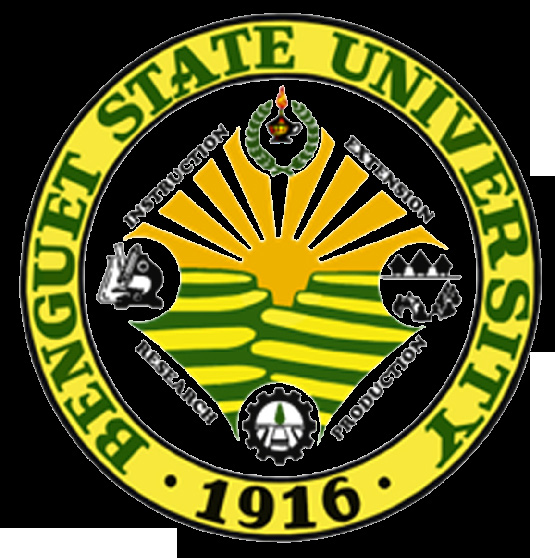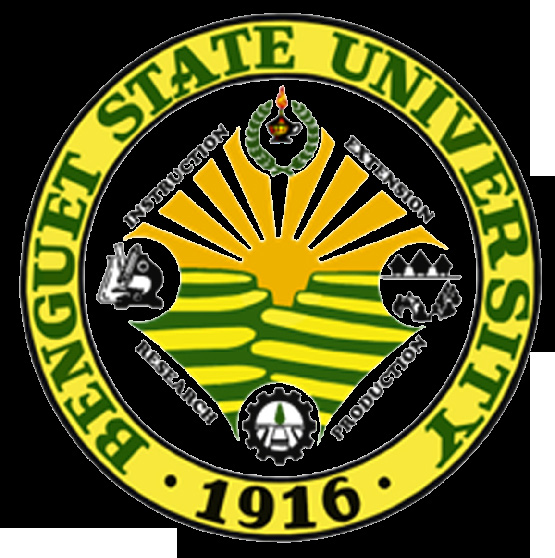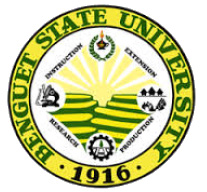Benguet State University RESEARCH JOURNAL ISSN 0117-5297 ...

Benguet State University
RESEARCH JOURNAL
ISSN 0117-5297 No. 69
January-June 2013
CONTENTS
RELATIONSHIP BETWEEN UNIVERSITY STUDENTS’
MULTIPLE INTELLIGENCES AND ACADEMIC PERFORMANCE. . . . . . . . . . . . . . . . . . . . . . 1-14
J. V, Lubrica and M. A. B. Lubrica
NEGOTIATIING CLIMATE CHANGE: VULNERABILITIES
AND RESILIENCE OF FOUR BENGUET COMMUNITIES. . . . . . . . . . . . . . . . . . . . . . . . . . . . . 15-46
F. G. Calora Jr., R. S. Batani, J. Napaldet, M. Camfili,
M. Gapasin and K. C. Ngina
DEVELOPMENT OF A GRADUATE EDUCATIONAL
RESEARCH COMPETENCY TEST (GER-CT). . . . . . . . . . . . . . . . . . . . . . . . . . . . . . . . . . . . . . . . 47-63
J. L. S. Montemayor
GEOGRAPHIC INFORMATION SYSTEM OF VEGETABLE
AND CROP PRODUCTION IN BENGUET . . . .. . . . . . . . . . . . . . . . . . . . . . . . . . . . . . . . . . . . . . . 64-101
J. B. Lacea
BENGUET STATE UNIVERSITY
La Trinidad 2601 Benguet
Philippines
All communications should be addressed to:
THE EDITOR
BSU Research Journal
Benguet State Univeristy
La Trinidad, Benguet 2601, Philippines
Telefax:( +6374) 422-5547
Email address: bsupublications@gmail.com or
repo@bsu.edu.ph
Website: www.bsu.edu.ph

Benguet State University
RESEARCH JOURNAL
This multidisciplinary scientific journal publishes selected
papers but not limited to those presented during the
annual Benguet State University Agency In-House Review
(Agriculture, Forestry and Natural Resources, Social and
Education Sectors).
Editorial Board
EDITOR
Luciana M. Villanueva, PhD
office of the Vice President for Research and Extension
Associate Editors
Gilda B. Jacalan, PhD
University Public Affairs Office
Christine Grace B. Sidchogan, MS
Department of Development Communication
College of Agriculture
Layout Arrtist/ Circulation Assistant
Marie Fe B. Wance
Office of the Vice President for Research and Extension
Proofreader
Sherielyn B. Banglig
Office of the Extension Services
TECHNICAL EDITORS
Maria Nancy Florendo, PhD
(University of the Philippines-Baguio)
Magdalena Wanawan, PhD
(Department of Agriculture-CAR)
Norma Maria Rutab, PhD
(University of the Cordillera)
Wilfredo Alangui, PhD
(University of Baguio)
Lorenza Lirio, PhD
(BSU-College of Arts and Sciences)
Marissa Parao, PhD
(BSU-College of Forestry)
Leonila Sito, PhD
(BSU-College of Teacher Education)
Ruth Batani, MS
(BSU-College of Arts and Sciences)
Joel Lubrica, PhD
(BSU-College of Arts and Sciences)
Percival Alipit, PhD
(BSU-College of Agriculture)
Janet Lyn Montemayor, MA
(BSU-College of Teacher Education)
EDITORIAL CONSULTANTS
Ben D. Ladilad, PhD
Office of the President
Benguet State University Research Journal (BRJ) January-June 2013, 69: 1-14
Copyright 2013, Benguet State University
RELATIONSHIPS BETWEEN UNIVERSITY STUDENTS’ MULTIPLE
INTELLIGENCES AND ACADEMIC PERFORMANCE
Maria Azucena B. Lubrica & Joel V. Lubrica
College of Arts and Sciences
Benguet State University
ABSTRACT
Multiple Intelligences (MI) theory asserts that individuals have distinct
intelligences in at least eight areas: Naturalistic, Linguistics, Logical-Mathematics,
Musical, Bodily-Kinesthetic, Visual-Spatial, Interpersonal, and Intrapersonal. In
teaching-learning situations, the MI of students has to be considered because these are
related to their academic performance. The aim of the study, therefore, was to determine
the relationships between MI and academic performance.
An inventory was used for data collection on MI; for academic performance,
final grades were obtained. Results through correlational analysis indicate that for First-
Year and Second-Year students, there were no significant relationships between MI and
academic performance.
For Third-Year students, there was a significant positive relationship between
Logical-Mathematical intelligence and academic performance, but a significant negative
relationship between Musical intelligence and academic performance. For Fourth-Year
students, there was a significant negative relationship between Bodily-Kinesthetic
intelligence and academic performance.
Keywords: Multiple Intelligences, Academic performance, Statistics students
Benguet State University Research Journal (BRJ) January-June 2013, 69: 15-46
Copyright 2013, Benguet State University
NEGOTIATING CLIMATE CHANGE:
VULNERABILITIES AND RESILIENCE OF FOUR
BENGUET COMMUNITIES
Feliciano Calora Jr., Ruth Batani, Jones Napaldet, Matyline Camfili,
Mursha Gapasin, K. C. Ngina
Benguet State University
ABSTRACT
A part of a bigger project titled Enhanced Climate Change Adaptation Capacity
of Communities in Contiguous Fragile Ecosystems in the Cordillera under the program
Strengthening the Philippine Institutional Capacity for Adaptation to Climate Change,
the study is a socioeconomic profiling and assessment of the vulnerability and adaptation
mechanisms of Benguet communities to climate change. Conducted with another parallel
study, the biophysical characterization of selected Benguet communities was done using
key informant interviews, focus group discussions, and survey. Results indicate that
Benguet communities with variable sources of livelihood are more resilient. Climatic
changes observed and felt by respondents generally agree with observed changes by
PAGASA noted as still ‘normal’ although the temperature and rainfall pattern are
pronounced as some of the manifestations of climate change. These communities are
also replete with mechanisms both at the farm and household level to negotiate changes
in the climate. Such mechanisms, however, are not necessarily sustainable.
Keywords: climate change, indigenous peoples, agricultural calendar, vulnerabilities
and resilience, Benguet
Benguet State University Research Journal (BRJ) January-June 2013, 69: 47-63
Copyright 2013, Benguet State University
DEVELOPMENT OF A GRADUATE EDUCATIONAL
RESEARCH COMPETENCY TEST (GER-CT)
Janet Lynn S. Montemayor
College of Teacher Education
Benguet State University
ABSTRACT
Admission to a graduate program comes with an assumption that a student
can do research independently. Unfortunately, in most cases, the assumption proves
otherwise. Research is blamed for the dropping survivability and rising drop-out rate
among graduate schools. This study aimed at developing a 50-item test that would
gauge the graduate students’ research competency. A pool of multiple choice items
(k=100) was constructed and was administered to a development sample (n=300)
composed of Master’s degree students. Results show that the Graduate Educational
Research Competency Test (GER-CT) is a reliable measure of research competency
(α = 0.734). Principal component analysis using orthogonal rotation with Kaiser
normalization identified five underlying factors of the GER-CT: perception,
numeracy, application, analysis, and evaluation.
Keywords: test development, research competency, graduate education, principal
component analysis
Benguet State University Research Journal (BRJ) January-June 2013, 69: 64-101
Copyright 2013, Benguet State University
GEOGRAPHIC INFORMATION SYSTEM OF VEGETABLE
AND CROP PRODUCTIONS IN BENGUET
John B. Lacea
College of Arts and Sciences
Benguet State University
ABSTRACT
Commercial Geographic Information System (GIS) applications are expensive
and difficult to understand because of their complex features, which are not always
used or applicable in some research studies. Although there are open and free source
GIS applications, they lack the most needed features in this undertaking. Customarily,
application trims down the complexity features and contains proper solution to typical
research study. This IT research tackled the prototype and framework for the development
of GIS tool in gathering and presenting data that will direct solution to some problems of
vegetable and crop production in Benguet. The methods and tools for data acquisition,
analysis, and visualization are implemented in the software architecture model.
Keywords: Decision-Support System, Factor Analyses, GPS, Information System,
Spatial Data Analysis, Software Architecture, UML
INFORMATION FOR CONTRIBUTORS
(Abridged/improved from the editorial policies of the Benguet State University)
1. All manuscripts must be the result of research activities (technical or social) that are relevant to the development
thrust of the University and should not have been published elsewhere.
2. Acceptance of manuscript is on the basis of the review and approval by a corps of technical editors and selected
referees.
3. Original photos should be submitted in PNG or JPEG format with corresponding captions.
4. The manuscript should not exceed 40 pages, typed double spaced in 12-point Times New Roman on one side of
81/2” paper with margins of 3.81 cm on the left and 2.54 cm top, right and bottom and must be submitted in hard
and electronic copy via bsupublications@gmail.com using MS Word Program.
5. The manuscript should be organized in the following order: (a) Title; (b) Authors/s; (c) Authors/s position;
(d) Abstract; (e) Introduction; (f) Materials and Methods; (g) Results and Discussion; (h) Conclusions and
Recommendations; (i) Acknowledgment, optional; and (j) Literature Cited ; and written all centered.
6. The title should be a precise and concise description of the contents of the manuscripts without abbreviations and
typed in upper case. If the paper is a portion of a larger manuscript, which shall be serialized and will be indicated
in a superscript followed by a brief explanation.
7. The author(s) name(s) is/are written in this way: initial letter for the middle names only, first and family names in
full and typed in title case. Senior author comes first in case of more than one author.
8. The abstract must be 200 words or less, summarizing the main points of the articles.
9. The introduction should contain scope and statement of the problem, brief survey of previous work and objectives
and importance of the study.
10. Citations in the text follows the name and year system, e. g.
Single Author:
(Adeyemo, 2010), Yeo (2009) or Boquiren (n.d.)
Two Authors:
Pladio and Villasenor (2004), (Pladio and Villasenor, 2004)
More than Two Authors:
Folbre et al. (2011) or (Folbre et al., 2011).
11. Materials and methods should describe very concisely but comprehensively the materials used, techniques, and
lay-out of the research.
12. Scientific names and other foreign expressions such as in situ, et al., i.e., and other similar expressions are italicized.
Technical terms, abbreviations and acronyms must be defined.
13. In abbreviating or using acronyms, the System International-Units (SI) of the metric system should be followed.
Such abbreviations or acronyms should be written first in full before the truncated terms in parenthesis, e.g. thin-
layer chromatography (TLC). If this information is given in the abstract, it should be re-identified when mentioned
the first time.
14. The results should be presented logically and in objective way and conclusions stated as valid facts.
15. The discussion of results should lead to interpreting significance and /or possible similarity or discrepancy from
previous findings.
16. A statement on conflict of interest should be declared by authors before the Acknowledgment section. Where
appropriate, Conflict of Interest statements may be in instances such as:” There are no known conflicts interests
associated with the publication” or “There has been no significant financial support for the work that could have
influenced its outcome.” Whenever appropriate, acknowledgements are made relevant for contributions in terms
of financial and technical support.
17. Literature cited in the text should be indicated as follows: Consolacion (2000) or (Consolacion, 2000); for two
authors, Colting and Maddul (1999) or (Colting and Maddul, 1999); for more than two authors, Bucu et al. (1999)
or (Bucu et al., 1999).
18. Electronic sources must be cited as follows: author (s), year, title, date of retrieval and the complete Uniform
Resource Locator (URL) of the site.
19. Listing of literature cited is by author(s) in alphabetical order. The list contains: author (s), year, title of literature,
publisher, address of publisher, volume and issue numbers and inclusive pages (printed as 1(2):1-9). Names of
authors are typed in upper case: for single author, surname (separated by a comma) first before the initials of the
given and middle names; for multiple authors, surname then initials of senior author followed by initials then
surnames of succeeding authors. Authors are separated by commas.
Single author:
Mondejar, L.A. 1998. Understanding Student Judgments of Teaching Performance: A Conjoint Approach.
Unpublished Doctoral Dissertation, University of the Philippines. Diliman. Quezon City.
Durano, M. 2008. From profit to provisioning: A gender equitable public policy. Development Alternatives
with Women for a New Era. QC: Miriam College.
Eriksen, T. 2001. Small Places, Large Issues. An introduction to Social and Cultural Anthropology. 2nd ed.
London: Pluto Press.
Two authors:
Hallauer, A. R. and F. O. Miranda. 1980. Quantitative Genetics in Maize Breeding. Iowa State University
Press. Ames, Iowa. Pp. 49-52.
Carrasco, C. and M. Serrano. 2011. Lights and Shadows of Household Satellite Accounts: The Case of
Catalonia, Spain. Feminist Economics 17 (2): 68-85. IAFFE: Routledge Taylor and Francis Group.
Crisologo, L. C. and L. Berlage. 2006. Bargaining in rural households: a study of decision on labor market
participation in the Cordillera. The Philippine Review of Economics. 48 (2): 249- 537.
More than two authors:
Linsley, R., J. Franzini, D. Freyburg and G. Tchobanoglous. 1992. Water Resources Engineering. 4th ed.
McGraw-Hill, Inc. New Jersey, USA.Pp. 510-532.
Aguilar, N. O., B. L. Cardenas and M. A. O. Cajano. 2000. Spore and Seed bearing Plants of Mount Pulag,
Benguet, Philippines. Museum of Natural History. UPLB, College, Laguna, Philippines.
Braunstein, E. B., I. P. Van Staveren and D. Tavani. 2011. Embeding care and unpaid work in Macroeconomic
Modelling. A structural Approach. Feminist Economics. 17, 4-31.
20. If necessary, protocols for manuscript preparation can be requested from the Editorial Board.
21. Please see the latest issue of the Journal for concrete details as to format.

BSU Research Journal No. 75
BSU Research Journal No. 75
VISION
A premier State University in Asia.
MISSION
Development of people imbued with academic excellence, social conscience and productivity; and
actively generating and promoting environment-friendly, useful technologies to improve quality of life.
GOALS
1. Strengthen and sustain a working environment conducive for excellence;
2. Provide quality education that will produce globally competitive and well-rounded graduates;
3. Provide quality and client-responsive research and extension services;
4. Strengthen and enhance institutional capability in generating revenue towards self-reliance
5. Develop and strengthen quality management system towards economy; and
6. Strengthen and expand private public partnership.
PURPOSE
* To provide quality education that will produce globally-competitive graduates;
* To generate and disseminate appropriate knowledge and technologies that will promote sustainable
resource development;
* To strengthen and enhance institutional capability in generating revenue towards self-reliance;
* To establish competent and effective services geared towards efficiency and economy; and
* To develop harmonious and cooperative University Community relationships.
Benguet State University
RESEARCH JOURNAL
All communications should be addressed to:
THE EDITOR
BSU Research Journal
Benguet State University
La Trinidad 2601 Benguet, Philippines
Telefax: (+6374) 422-5547
Email address: bsupublications@gmail.com
Website: www.bsu.edu.ph
11 11